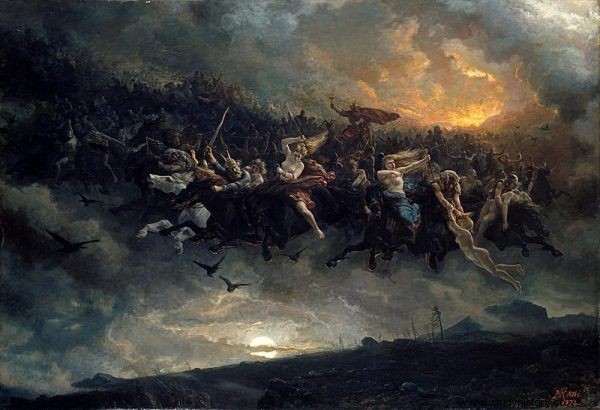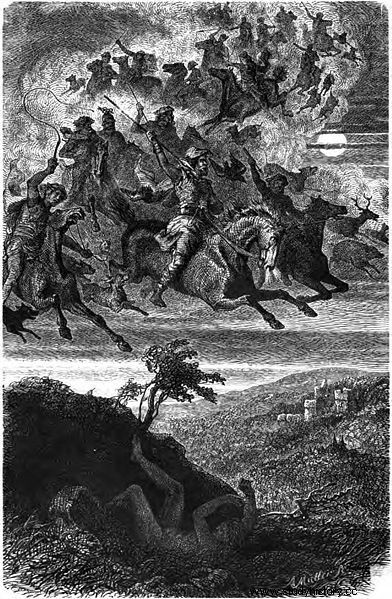Today, the long-awaited Netflix series "The Witcher", based on the cult books by Andrzej Sapkowski, has its premiere. Wild Hunt is one of the most important themes in this story. It was he who also gave the title of the third part of the equally cult game. What is this mythical pursuit?
The concept of the Wild Hunt belongs to the group of the most widespread mythological themes in Europe. Its roots are to be found among the beliefs of Indo-European peoples, and although most accounts come from Germanic areas, this motif can also be found in the Celts and Slavs. The prototype of the mad chase in the sky can be considered the retinue of Odin or Wodan, who in German-Scandinavian mythology was to take the fallen warriors to Valhalla. Over time, it became more demonic and served completely different purposes.
The concept of the Wild Hunt was first described by Jacob Grimm in his book "Deutsche Mythologie" (German Mythology) published in 1835. Looking at the idea of "furious hunting", he also noticed that this motif was much older than Christianity, but it was not finally ousted, but adapted to the new faith. This means that the Wild Hunt was firmly embedded in people's minds.
Enraged Army
Wild Hunt is the term for the sky pursuit of an army of ghosts. Depending on beliefs, they could be ghosts, ghouls, mythological characters who were led by a male or female deity or a demon.
It was also believed that the souls of sleeping bad people, especially witches and sorcerers, could join the retinue. In its original version, Odin / Wodan was at the head of the retinue, with time he was replaced by his other personifications, as well as goddesses, e.g. Freya, Lusse or Hölle. Leadership could also be given to folk incarnations of characters from ancient stories like the witch Guro Rysserova - Gudrun with a Ponytail, who was the incarnation of Gudrun known to us from the lines of Poetic Edda or the Krymhilds from Songs of the Nibelungs .

Peter Nicolai Arbo:Åsgårdsreien (1872)
A mortal could also take command of the pursuit. This honor went to such historical figures as Gudelac of Mercia (673–714) or the Catholic bishop Bernhard von Galen (17th century). We also meet alternative incarnations of authentic people, such as in Denmark, the ruler of the Hunt was King Vold - the evil alter ego Waldemar IV Atterdag (ruled in the years 1340–1375).
If you look closely at the Wild Hunt, you will come to the conclusion that their original leader, the Norse god Odin, was perfect for this function. He rode an eight-legged steed, which even in the mythical tale was considered strange, was the ruler of heavenly warriors and patronized the berserkers - crazy earthly warriors. he always did what was best for them. Isn't such a crazy god really the best candidate for a leader in a wild, wild pursuit of the heavens?
Beware mortals
The Wild Hunt was not an ordinary phenomenon. The procession could be seen in the winter sky, starting with the Julian holiday, which today would fall between Christmas and the Epiphany, until early spring. The Wild Hunt was accompanied by dark clouds, a storm in the sky and cataclysms on the ground.
Who were the furious ghouls hunting for? According to Danish beliefs on the Slattenpat trinity, in England and Germany on the moss people (a kind of forest elves); and regardless of the region, also to those who, in their misfortune or stupidity, stood in their way.
Interestingly, the diversity of opinions about the Wild Hunt did not stop at their leadership alone. Depending on the area of the Indo-European world that we choose to look at, we will find various superstitions related to the Wild Hunt. In some instances, a mortal who would witness this event was threatened with death, in others, the ghosts carried him off into the afterlife. If he was lucky he could get gold from the participants of the Hunt; on the other hand, if he allowed himself to be mocked at the retinue as a pagan custom, he was killed or turned to stone.

Franz von Stuck "Die Wilde Jagd"
During the Wild Hunt, the household could also be haunted by a black stray dog. He was considered the epitome of one of Odin's wolves running with him in a chase . If the animal could not be driven away by trickery, it would have to be fed for the next year until the next storm season.
Also very spectacular was the replacement of human legs with animal paws or legs of the deceased. Who could have had such a swap? A person who was reckless enough to stand in the way of rushing ghosts. Such a person was considered haunted and had to quickly seek help from a sorcerer or deduce a trick on his own that could undo such a charm.
Christian superstitions pagan origins
As I mentioned earlier, the Wild Hunt was adapted by Christianity and also in these times, depending on the country, you can find different varieties of it. A dozen to several hundred ghosts were to participate in the chase across the sky in the form of demons, warriors, witches, sinners and the souls of unbaptized children. They rode various mounts (black horses, fiery figures or horned demons) and were accompanied by various animals and creatures (usually dogs, but often also dragons).
Why did Christianity replace the original spirits of the warriors in the Wild Hunt with ghosts and demons? By introducing a new faith, it was necessary to depreciate the old beliefs and, more importantly, the old deities to which people were so attached. They were then replaced by hosts of saints and angels.
Why Wild Hunt?
What role did the Wild Hunt play in ancient beliefs? The search for an answer to this question has long occupied the minds of many scientists. Myths and superstitions usually arose to explain all kinds of phenomena and events over which people had no influence . So what could explain a maddened retinue rushing through the heavens led by a maddened deity like Odin or Lusse?
On the one hand, it may be related to the cult of the dead and beliefs related to the afterlife. In Germanic mythology (with particular emphasis on the Norse) it was believed that the fallen warriors went to Valhalla. The Wild Hunt could therefore be associated with the entertainment of their souls, which went hunting before the evening feast .

Friedrich Wilhelm Heine:Wodan's wilde Jagd (1882)
Another theory suggests that Gon was associated with the advent of troops to Ragnarök - the final battle at the end of the world. So why should this happen every year during the winter storm season? For the people of those days, natural disasters such as fires and floods certainly grew into events comparable to the end of their everyday world.
When studying the Wild Hunt, it is worth paying attention to one name that stands out from the others, which suggests that the Wild Hunt was the complete opposite of what was described above. Woe jäger - in Middle or Old German it means Hunters of Good Luck. It seems that the term comes from the language of the warriors of old, who in this expression wanted to preserve all the benefits that pagan religion gave to the fallen in glory. In addition to the promise of a happy life in the afterlife, the Wild Hunt would also herald the prosperity that the hosts of heavenly warriors sent to the mortals in the form of heavy rains.
The Wild Hunt theme was extremely popular both in the ancient beliefs of Indo-European peoples and in Christian times. This fascinating phenomenon fascinates and inspires many to this day. Dziki Gon has become a popular theme used in music (e.g. metal), art, literature and pop culture. We will meet him with A. Sapkowski in the series about the Witcher Geralt, with H. Sienkiewicz in "The Deluge", J. Foxe in "The Wild Hunt", J. Yolen "The Wild Hunt" or M. Moorcock in the cycle about von Bek ("Żołdak and the evil of the world").
